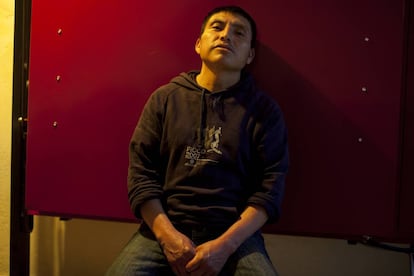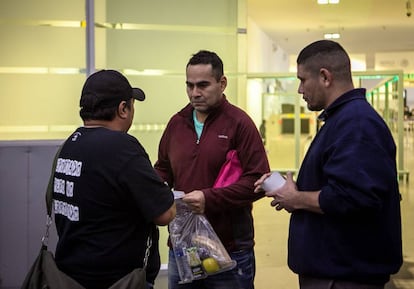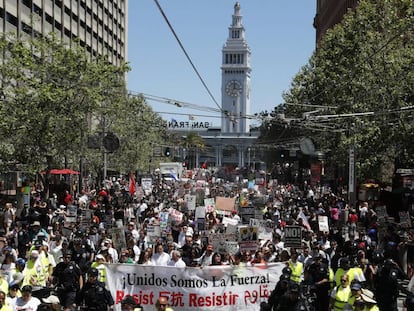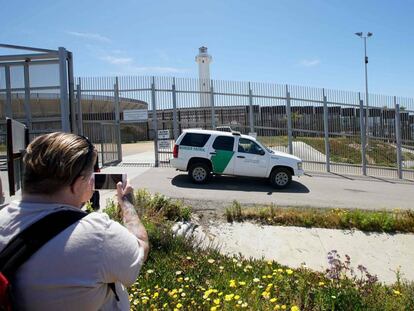“I never felt as though I was on Trump’s deportation list”
Although deportations from the United States have dropped, there has been a spike in arrests of migrants with no criminal records


At the age of 29, Felipe Alcaraz has been a soldier, a dairy worker and an urban inspector. He has picked lemons and tamarind fruit, and built houses. He has had girlfriends and also his fair share of heartache. And, at times, he has been happy. But now, Felipe is a deportee after being categorized a priority alien.
Since his deportation to Mexico a week and a half ago, his existence seems defined by what he can’t do, such as live in the US, work at the dairy farm, see his brother, or save dollars. He can’t, in short, continue with his life.
A native of Mexico’s Colima State on the Pacific coast, Felipe is the ‘every immigrant’ of the Trump era; the archetypal deportee: a worker living in inland states with no criminal record.
According to data from the Mexican internal affairs department, the Secretaría de Gobernación, deportations actually fell in number in the first nine months of 2017 as Trump settled into the White House. There were, in fact, 27% fewer removals than in the same period of Obama’s last year in office: from 151,460 down to 109,842.
However, the number of deportations taking place far from the Mexican border have increased. While most deportees were once immigrants who had just entered the US, they are now more likely to be people like Felipe.
Arrests of undocumented immigrants with a clean record have risen by 150%
In the first year of Trump’s presidency, the number of arrests and deportations of immigrants with no criminal record has also risen. In the first few months, arrests of undocumented immigrants with a clean record rose by 150%, according to figures from the US Immigration and Customs Enforcement (ICE) department.
“I lived in Sunnyside in Washington state,” says Felipe, who is tall and shy with cropped hair. “I had been there for two years. I worked at a dairy farm. One day, in the afternoon, I was stopped on my way to work. I was driving my brother’s truck. They stopped me and asked for my license. It seemed odd because they weren’t driving a patrol car. I told them I didn’t have a license. Then one of them came up to me and showed me a photo on his cellphone. ‘Do you know this person?’ they said. And it was me! It was my photograph!”
Felipe, who insists he has never had any trouble with the law, believes they took it from his Facebook page. It had never occurred to him that the “ICE people” would be looking for individuals like him, and he certainly had never imagined they would be seeking him out on social networks. “I never felt as though I was on Trump’s list,” he says.

It is hard to define Trump’s list. In the months he has spent at the White House and on the campaign trail, the tycoon’s immigration policy and its goals have come across as erratic at best. Does he want to get rid of the ‘bad hombres’, as he calls criminals and delinquents? Does he want to get rid of special migrant programs such as DACA, which protects children brought illegally into the US, or the TPS, which does the same thing for immigrants from El Salvador? Is the wall with Mexico the only thing he cares about?
Eunice Rendón, a Mexican expert on immigration, summed up the situation several weeks ago in Nexos magazine. “Under the Obama administration, the priorities and categories for deportation were different; they included those with serious criminal records and anyone considered a threat to the country’s security. Now, everyone is priority,” she writes.
Oliverto Pérez, 35, from the Mexican state of Chiapas, is another immigrant who has become a priority alien. A short, thin man, he lived in Pittsburg for seven years earning a living as a plasterer, dishwasher and kitchen assistant. His last job was helping out in a Korean restaurant, but he left due to differences with the manager. One day, he says, he was walking down the street in a white neighborhood when ICE officers approached him. “They took me to the county jail,” he says.
You can decide if you want to fight it or not. I didn’t Felipe Alcaraz
From there he was transferred to another jail until he ended up in a large prison for deportees. “That’s where you can decide if you want to fight it or not,” he says. “I didn’t.” So he was sent back to Mexico in December and now works as a dishwasher in Mexico City. “Here’s it’s a battle to get the grease off,” he says comparing his hands to the dishwasher he operated in the US. Although he is referring to the plates, it is almost as if he was referring to himself and how hard everything now seems as a 35-year-old deportee. “I’m already old,” he says quietly.
Every Monday, Tuesday and Wednesday at midday, the deportation plane lands in Mexico City. Dozens of immigrants disembark without luggage, gifts or anything to indicate that they are normal passengers who might be on holiday or visiting relatives. Each one carries a sealed plastic bag containing a juice box, a bottle of water and a ham sandwich. On arrival, some rush off to eat while others buy an ongoing ticket to get closer to home. Some, like Felipe and Oliverto, look for a place to sleep in the capital and stay for a few days, or for who knows how long.
The future does not look bright for these two. Felipe could go back to Colima, but to what? He says that he left years ago because of the violence. It got to the point that the criminals were imposing a curfew.
In Oliverto’s case, it was poverty, not violence, he was leaving behind him. “There are people who grow coffee and they do well, but I don’t have that. I used to plant maize and beans but the land began to suffer from too many pesticides,” he says.
English version by Heather Galloway.

